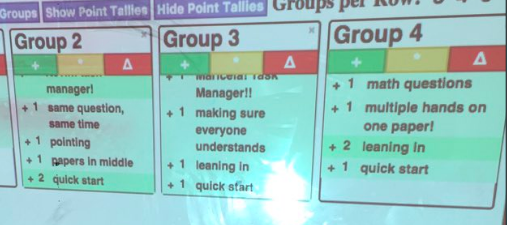One of my favorite things about working at my new school is they way in which students are encouraged to learn together. In fact, it isn’t just encouraged; it is how learning happens in every class.
A strategy that my planning partner and I use regularly is the explanation quiz. It is basically a task designed to help students explore a concept and work together to understand the concept. Here are a couple of the main things needed to make it run smoothly:
1. Every student in the group needs a role.
The four roles I use are:
(1) Group manager – in charge of checking understanding and process checking,
(2) Task manager – in charge of making sure that everyone understands what the task is and is participating,
(3) Communications manager – in charge of sharing ideas with the class and making sure ideas and voice within the group are equitable, and
(4) Resource manager – in charge of making sure the group has supplies and in charge of relaying questions to the teacher.
2. Students should be aware of expected group norms and “ways to be smart”.
These are some of our norms:
- Everyone needs to understand
- Same question, same time
- Talk first, then write
- Group questions only
- Group talk only
These are some of the ways I say students can “be smart”:
- Papers in the middle of the table
- Pointing
- Leaning in
- Using ________ (whiteboard, protractor, patty paper, desmos, translator, etc.)
3. Students need to get feedback on their work.
My favorite new tool of the school year is http://mrpinsky.github.io/. It is simple to use and allows you to document the way students are doing well or not doing well. You can give points to students that are doing good work and comment on it out loud saying, “I like how group 3 is leaning in and Marcos is helping make sure everyone in his group understands”. Students pay attention to this and start to mimic the work. Often, students will say “Mister, we are leaning in, why didn’t you give us points?” Likewise, you can type “phones out” without saying anything and a student on their phone will quickly be scolded by their group mates.
4. Space to work.
One of the most difficult things for me as a teacher this year was to learn to get out of the way. When you create a classroom system that encourages students to work together you need to give them space to do it. It is okay to step back and let them work; in fact, it is the best way to let them thrive. The goal is for groups to use each other and be in charge of advocating for help only after they have consulted each other. One easy way to do this is to limit the number of questions a group can ask the teacher (I usually do a 2 questions limit that works well).
With all that being said, the amount to which students are equitably accessing the content and learning remains my main focus this semester. I wonder what other structures I can give groups to improve the amount students can learn together, and I’m trying to find that sweet spot between helping groups and letting them work without me. Please share these resources with teachers you know and let me know if you’ve found other methods that help engage students in collaboration!
Shout out to my planning partner https://twitter.com/SergtPeppa.

